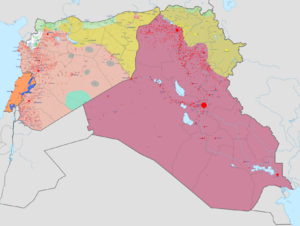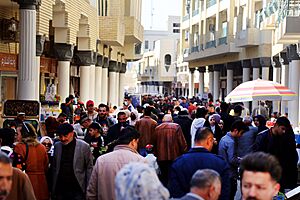History of Iraq (2011–present) facts for kids
The U.S. troops left Iraq in 2011. This ended a time when the U.S. had a big role in the country, which started with an invasion in 2003. After the U.S. left, new fighting began in Iraq. The Syrian civil war also affected Iraq. By 2013, the fighting grew into a full war. The main government of Iraq fought against a group called ISIL and other groups, mostly Sunni fighters. The war ended in 2017 with the Iraqi government winning. However, ISIL still causes some trouble in quiet parts of the country.

Controlled by Iraqi government Controlled by Islamic State Controlled by Iraqi Kurds Controlled by Syrian government Controlled by Syrian rebels Controlled by Syrian Kurds
ISIL fighters took control of most of the Al Anbar Governorate. This included cities like Fallujah, Al Qaim, Abu Ghraib, and later Ramadi in 2015. This meant they controlled 90% of Anbar. In June 2014, ISIL also took Tikrit, Mosul, and most of the Nineveh Governorate. They also captured parts of Salahuddin, Kirkuk, and Diyala Governorates. ISIL captured Sinjar in August 2014, but fighting continued there.
Contents
A New Start and New Challenges (2011-2013)
Rising Tensions and Protests
In 2011, protests like those in the Arab Spring spread to Iraq. These protests did not remove the government. The Iraqi National Movement stopped attending Parliament for some weeks. They said the government, mostly led by Shia Muslims, was trying to push out Sunni Muslims.
In 2012 and 2013, violence grew. Armed groups in Iraq became more active because of the Syrian Civil War. Both Sunni and Shia fighters went to Syria to join the conflict. In December 2012, Sunni Arabs protested against the government. They felt the government was ignoring them.
The Rise of the Islamic State
During 2013, Sunni militant groups increased their attacks. They targeted people in Iraq to make them lose trust in the government led by Nouri al-Maliki. In 2014, Sunni fighters from the Islamic State group took over large areas. They captured several major Iraqi cities, such as Tikrit, Fallujah, and Mosul. This caused hundreds of thousands of people to flee their homes. There were also reports of terrible acts by ISIL fighters.
On June 4, 2014, the fighters began to capture Mosul. The Iraqi army had many soldiers and police in the city. But their actual numbers were lower than expected. This made it hard for them to fight. After six days of fighting, Iraqi soldiers were told to leave. The city of Mosul then fell to ISIL. About 500,000 people ran away from the city.
The War Against the Islamic State (2013-2017)
International Help and New Leaders
By mid-2014, Iraq was in a difficult situation. A new government had not yet been formed after elections. The fighting was getting worse. In early June 2014, the Islamic State in Iraq and the Levant (ISIS) took over Mosul and Tikrit. They said they were ready to attack Baghdad. At the same time, Iraqi Kurdish forces took control of important military places in Kirkuk, a city known for oil. Prime Minister Nouri al-Maliki asked Parliament to declare a state of emergency. This would give him more power, but lawmakers said no.
In the summer of 2014, U.S. President Obama announced new military help. This included air support to stop ISIS and give aid to people who had to leave their homes. The goal was also to make the political situation more stable.
Since June 2014, al-Maliki faced pressure to step down. This pressure came from inside Iraq and from other countries like the United States. In July 2014, the Kurdistan Region asked him to resign. Even his own party started looking for a new leader.
On August 14, 2014, Prime Minister Nouri al-Maliki agreed to step down. Iraq's new president, Fuad Masum, chose Haider al-Abadi as the new prime minister on August 19, 2014. Al-Abadi needed to form a government and get approval from Parliament within 30 days. Al-Maliki first disagreed with al-Abadi's choice, but then he supported him.
Fighting Back and Taking Cities
The Islamic State, which had changed its name, continued its attacks. On August 22, 2014, suspected Shia fighters attacked a Sunni mosque during prayers. About 70 worshipers were killed. Iraqi forces also killed 30 Sunni fighters in Dhuluiya. The next day, three bombings across Iraq killed 35 people. These attacks seemed to be in response to the mosque attack.
The Kurdistan Region also fought against ISIL. They took control of other areas, like Kirkuk. Since August 2014, the U.S. has been bombing ISIL positions. In late January 2015, Iraqi forces took back the entire Diyala province from the Islamic State.
On March 2, the Second Battle of Tikrit began. After more than a month of hard fighting, Iranian, Iraqi, and Shia militia groups defeated ISIL fighters and took Tikrit. However, in late May, ISIL captured Ramadi, the capital of Anbar Governorate.
Iraqi Prime Minister Haider al-Abadi announced on July 10, 2017, that the city of Mosul was free from the control of the Islamic State of Iraq and the Levant.
Iraq Today: Elections, Protests, and Challenges (2018-Present)
New Leaders and Public Unrest
Parliamentary elections were held on May 12, 2018. A Kurdish politician named Barham Salih was chosen as president by Parliament in October 2018. Former Finance Minister Adil Abdul-Mahdi was asked to form a new government. This new government was approved by the Council of Representatives on October 24, 2018.
Protests started in July 2018 in Baghdad and other big Iraqi cities. People were upset about the economy and government corruption. The latest protests, which began in October 2019, led to the deaths of at least 93 people, including police.
In March 2018, Turkey started military actions to remove Kurdish fighters in northern Iraq. Muqtada al-Sadr's political group won the parliamentary election in May 2018. Serious public unrest began in Baghdad and Najaf in July 2018. It spread to other areas in September. People protested against corruption, unemployment, and poor public services. These protests sometimes became violent.
More protests started on October 1, 2019. They were against corruption, joblessness, and bad public services. Soon, people were calling for the government to be removed. They also wanted to stop Iran's involvement in Iraq. The government sometimes reacted strongly, leading to over 500 deaths by December 12, 2019.
On December 27, 2019, the K-1 Air Base was attacked with rockets. A U.S. civilian worker was killed, and others were hurt. The U.S. blamed an Iranian-backed group called Kata'ib Hezbollah. Later that month, the U.S. bombed five of Kata'ib Hezbollah's locations in Iraq and Syria. On December 31, many Iraqi Shia fighters and their supporters marched into Baghdad's Green Zone. They surrounded the U.S. embassy.
Ongoing Challenges
Three days later, tensions grew between the United States and Iran. The U.S. launched a drone strike near Baghdad Airport. This strike killed Qasem Soleimani, a top Iranian general. It also killed Abu Mahdi al-Muhandis, a leader of Iraq's Popular Mobilization Forces. Four other Iranian officers and four Iraqi officers also died.
After months of protests and the resignation of Prime Minister Adel Abdul Mahdi, Mustafa al-Kadhimi became a top choice for Prime Minister. On April 9, 2020, President Barham Salih named him as the new prime minister. On November 30, 2021, the political group led by Shia leader Muqtada al-Sadr was confirmed as the winner of the October election. A long period of political trouble followed for eleven months.
In June 2022, all 73 members of Parliament from the Sadrist Movement resigned. This was a move by Muqtada al-Sadr to challenge other rival Shia parties in Parliament. He wanted to show his dislike for the system set up in 2003. On July 27, 2022, the parliament building was stormed by protesters for the second time in a week.
In October 2022, Abdul Latif Rashid was chosen as the new President of Iraq. He won the election against the current president, Barham Salih. The presidency is mostly a ceremonial role and is usually held by a Kurd. On October 27, 2022, Mohammed Shia al-Sudani became the new Prime Minister of Iraq. He is a close friend of former Prime Minister Nouri al-Maliki.
In July 2023, large parts of southern and western Iraq lost electricity. This happened after a fire caused an explosion at a power station near Basra. Iraq's electricity system faces problems from climate change, lack of fuel, and more demand. Corruption is still a big problem in all parts of the Iraqi government. The political system has also led to more violence and conflicts between different groups.
Climate change is causing widespread droughts across the country. Water supplies are quickly running out. Iraq has been in a long drought since 2020. It had its second-driest season in 40 years in 2021. Water levels in the Tigris and Euphrates rivers are down by 30 to 40 percent. Half of Iraq's farmland is at risk of becoming desert. Almost 40 percent of Iraq is now covered by blowing desert sands. These sands take over tens of thousands of acres of good land every year. Many believe the Iraq war changed the country forever.
See also
- Iraqi insurgency (2011–2013)
- Iraqi conflict (2003–present)
- Northern Iraq offensive (June 2014)
- Northern Iraq offensive (August 2014)
- Arab Winter
- 2018 Iraqi parliamentary election
- 2021–2022 Iraqi political crisis
- History of Iraq


